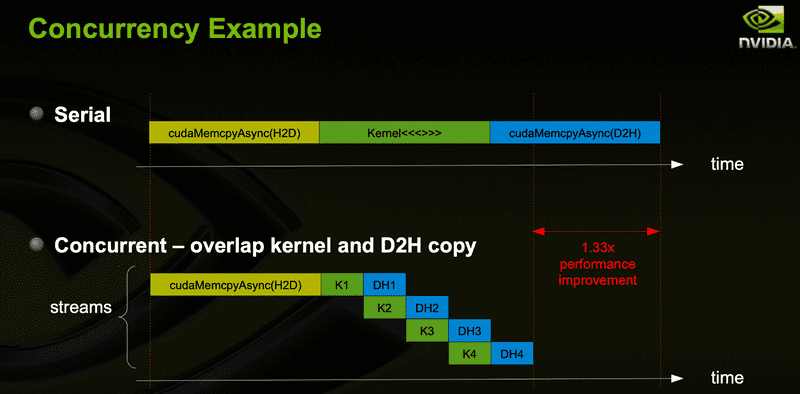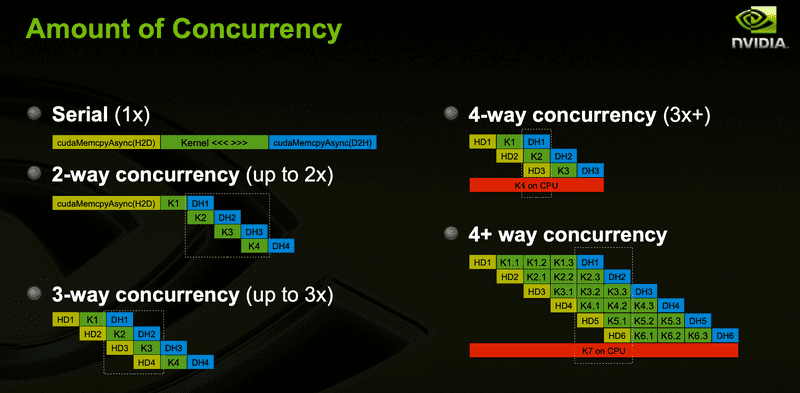The CUDA Parallel Programming Model - 9. Interleave Operations by Stream
In the last post, we saw how full concurrency can be achieved amongst streams. Here I’d like to talk about how CUDA operations from different streams may also be interleaved, which is another programming model often used to effect concurrency.
Review CUDA Streams
A stream in CUDA is a sequence of operations that execute on the device in the order in which they are issued by the host code.
While operations within a stream are guaranteed to execute in the prescribed order, operations in different streams can be interleaved and, when possible, they can even run concurrently.
Review CUDA Asynchronous Commands
Being asynchronous means that CUDA can perform these operations simultaneously
- CUDA Kernel <<<>>>
- cudaMemcpyAsync (HostToDevice)
- cudaMemcpyAsync (DeviceToHost)
- Operations on the CPU
🌟 What Can Happen Simultaneously 🌟
-
computation on the device
- lots of CUDA kernels on GPU
-
data transfers between the host and device
cudaMemcpyAsyncsboth HostToDevice and DeviceToHost
- computation on the CPU
No Concurrency
The two examples below are completely synchronous:
example 1
cudaMemcpy(d_a, a, numBytes, cudaMemcpyHostToDevice);
increment<<<1,N>>>(d_a)
cudaMemcpy(a, d_a, numBytes, cudaMemcpyDeviceToHost);-
From the perspective of the device:
- all three operations are issued to the same (default) stream, thus will execute in the order that they were issued
-
From the perspective of the host:
- the implicit data transfers are blocking or synchronous transfers
- the kernel launch is asynchronous
- 😳Since the host-to-device data transfer on the first line is synchronous, the CPU thread will not reach the kernel call on the second line until the host-to-device transfer is complete. Once the kernel is issued, the CPU thread moves to the third line, but the transfer on that line cannot begin due to the device-side order of execution.
example 2
cudaMemcpy ( dev1, host1, size, H2D ) ;
kernel2 <<< grid, block, 0 >>> ( …, dev2, … ) ;
kernel3 <<< grid, block, 0 >>> ( …, dev3, … ) ;
cudaMemcpy ( host4, dev4, size, D2H ) ;All CUDA operations in the default stream are synchronous.
Overlap Device and Host Computation
The asynchronous behavior of kernel launches from the host’s perspective makes overlapping device and host computation very simple.
In the modified code below, an independent CPU computation is added:
cudaMemcpy(d_a, a, numBytes, cudaMemcpyHostToDevice);
increment<<<1,N>>>(d_a)
myCpuFunction(b)
cudaMemcpy(a, d_a, numBytes, cudaMemcpyDeviceToHost);As soon as the increment() kernel is launched on the device the CPU thread executes myCpuFunction(), overlapping its execution on the CPU with the kernel execution on the GPU.
Whether the host function or device kernel completes first doesn’t affect the subsequent device-to-host transfer, which will begin only after the kernel completes.
From the perspective of the device, nothing has changed from the previous example; the device is completely unaware of myCpuFunction().
special note
GPU kernels are asynchronous with host by default.
Requirements For Concurrency
- The kernel execution and the data transfer to be overlapped must both occur in different, non-default streams.
-
Must
cudaMemcpyAsyncwith host from ‘pinned’ memory- Page-locked memory
- Allocated using cudaMallocHost() or cudaHostAlloc()
-
Sufficient resources must be available
- cudaMemcpyAsyncs in different directions
- Device resources (SMEM, registers, blocks, etc.)
- The device must be capable of “concurrent copy and execution”
Asynchronous with Streams
cudaStream_t stream1, stream2, stream3, stream4 ;
cudaStreamCreate ( &stream1) ;
...
cudaMalloc ( &dev1, size ) ;
cudaMallocHost ( &host1, size ) ; // pinned memory required on host
…
cudaMemcpyAsync ( dev1, host1, size, H2D, stream1 ) ;
kernel2 <<< grid, block, 0, stream2 >>> ( …, dev2, … ) ;
kernel3 <<< grid, block, 0, stream3 >>> ( …, dev3, … ) ;
cudaMemcpyAsync ( host4, dev4, size, D2H, stream4 ) ;
some_CPU_method ();
...The use of different, non-default streams make the code above fully asynchronous/concurrent. The four streams are potentially overlapped.
special note
Note that: data used by concurrent operations should be independent.
Overlap Computation and Data Transfers
for (int i = 0; i < nStreams; ++i) {
int offset = i * streamSize;
cudaMemcpyAsync(&d_a[offset], &a[offset], streamBytes, cudaMemcpyHostToDevice, stream[i]);
kernel<<<streamSize/blockSize, blockSize, 0, stream[i]>>>(d_a, offset);
cudaMemcpyAsync(&a[offset], &d_a[offset], streamBytes, cudaMemcpyDeviceToHost, stream[i]);
}In the modified code, we break up the array of size N into chunks of streamSize elements. Since the kernel operates independently on all elements, each of the chunks can be processed independently.
The number of (non-default) streams used is nStreams=N/streamSize. In the picture above there are 4 streams.
Synchronization
Explicit
-
Synchronize everything
- cudaDeviceSynchronize ()
- Blocks host until all issued CUDA calls are complete
-
Synchronize w.r.t. a specific stream
- cudaStreamSynchronize ( streamid )
- Blocks host until all CUDA calls in streamid are complete
-
Synchronize using Events
- Create specific ‘Events’, within streams, to use for synchronization
- cudaEventRecord ( event, streamid )
- cudaEventSynchronize ( event )
- cudaStreamWaitEvent ( stream, event )
- cudaEventQuery ( event )
example
{
cudaEvent_t event;
cudaEventCreate (&event); // create event
cudaMemcpyAsync ( d_in, in, size, H2D, stream1 ); // 1) H2D copy of new input
cudaEventRecord (event, stream1); // record event
cudaMemcpyAsync ( out, d_out, size, D2H, stream2 ); // 2) D2H copy of previous result
cudaStreamWaitEvent ( stream2, event ); // wait for event in stream1
kernel <<< , , , stream2 >>> ( d_in, d_out ); // 3) must wait for 1 and 2
asynchronousCPUmethod ( … ) // Async GPU method
}Implicit
These operations implicitly synchronize all other CUDA operations
-
Page-locked memory allocation
- cudaMallocHost
- cudaHostAlloc
-
Device memory allocation
- cudaMalloc
-
Non-Async version of memory operations
- cudaMemcpy* (no Async suffix)
- cudaMemset* (no Async suffix)
-
Change to L1/shared memory configuration
- cudaDeviceSetCacheConfig
Measure Performance Gain
To read more about concurrency and streams: https://developer.download.nvidia.com/CUDA/training/StreamsAndConcurrencyWebinar.pdf https://devblogs.nvidia.com/how-overlap-data-transfers-cuda-cc/


